|
.
A common criticism of the Guard was that it drew off the best men
from the line and from the conscripts, thereby robbing them of
potential sergeants and corporals. But it must be remembered that
Napoleon intended that the guard serves as a training ground
for the NCOs from the army so the guard functioned as a
military school.
For example sergeants of the Old Guard were commisioned as
the second lieutenants in the line. The Battalion of Instructions
was formed in 1811 and was set up to train the Young and Middle Guard
as corporals and sergeants for the newly formed regiments.
Napoleon wrote: "My Guard should contain cadres for a reserve of
100 battalions. These will require 3.000 sergeants and 6.000 corporals.
There are 2.300 Middle Guard and 12.000 Young Guard at present.
By holding on to the choice men we can eventually train 3.000 sergeants
and 6.000 corporals in the Young Guard".
|

Imperial Guard [Garde Imperiale]
They owed him their prestige and glory, which they paid for in loyalty.
From this reciprocity was born the spirit of the Imperial Guard.
It was the highest expression of the military spirit, which is
less a desire to fight than the desire to fight well ..."
In 1804 after his crowning, Napoleon transformed the Consular Guard into the Imperial
Guard (Garde Imperiale). A decree of July 29, 1804, stated: “The Consular Guard will take the title of Imperial Guard".
The decree also described recruitment: "Each regiment of infantry, cavalry, foot and horse artillery,
and each battalion of the train, prepared a list of 6 NCOs or privates likely to be called upon to belong to the Guard,
having met the measurements of the needs of that Corps.
The conditions to be included to fill these lists were:
- for the regiments of dragoons and horse chasseurs, at least 6 years of service,
2 campaigns: 1,73 cm tall (5'4")
- for the regiments of cuirassiers, and artillery, at least 6 years of service, 2 campaigns: 1,76 cm tall (5'5")
- for the regiments of line and light infantry, at least 5 years of service, 2 campaigns: 1,76 cm tall (5'5")
- for the battalions of the train, same time in service, and height of 1,678 cm (5'2")
... The soldiers chosen to enter the Guard remained with their troop, where they continued their service until the Minister of
War ordered them to be directed to Paris to be placed in regiments there."
There were problems however, for example the 29th Line Infantry had only 4 (instead of 10)
soldiers 5'9" with four years' service, and asked if 5'8" would do for a grenadier.
In winter 1803-4 the so-called Velites were formed.
The Velites were sort of enlisted volunteers to remedy the last evil by drawing from
them instead of the army. They were required to be young men of family.
This was to obtain a certain amount of education and character, with which is usually
joined a sense of honor. Allured by the splendid renown of Napoleon, dazzled by his numerous
victories, young men flocked to the ranks of Velites.
The Velites "gave more modest families and those without service traditions a way to place their sons directly as officers, thereby saving them from conscription while also proving their loyalty to the regime.
... Less than 18 % of the Velites came from civil service families (judiciary, administration).
More striking still, only 1.5 % came from military backgrounds. ... The majority were
classified as property holders - 46 % as land owners or rentiers, presumably well-off families that neither worked for a living nor exercised a public function, and a further
10 % in various branches of agriculture like wine-growing. Another 25 % came from commercial milieux,
the liberal professions, and artisan families."
(Blaufarb - "The French Army 1750-1820" pp 178-9)
In 1806 every battalion of line and light infantry were ordered to send 1 man to the Guard by 1 July.
The candidates must be under 35, strongg and tall (5,10" for grenadiers and 5'8" for chasseurs),
with 10 years service, and a citation for bravery. It soon appeared that these conditions
could not be fulfiled, even by lowering the term of service to 6 years.
1807
Grenadiers-à-Pied de la Garde Imperiale
Foot Grenadiers of the Imperial Guard
(Marshal Louis-Nicolas Davout)
(General Pierre-Auguste Hulin) |
Chasseurs-à-Pied de la Garde Imperiale
Foot Chasseurs of the Imperial Guard
(Marshal Jean de Dieu Soult)
(General Jerome Soules) |
 Regiment of Foot Grenadiers Regiment of Foot Grenadiers
(Colonel Claude-Etienne Michel)
 Regiment of Fusiliers-Grenadiers Regiment of Fusiliers-Grenadiers
(Colonel Jean-Parfait Friederichs)
|
 Regiment of Foot Chasseurs Regiment of Foot Chasseurs
(Colonel Jean-Louis Gros)
 Regiment of Fusiliers-Chasseurs Regiment of Fusiliers-Chasseurs
(Colonel Joseph Boyer de Rebeval)
|
The infantry of the Guard also acquired more foreign elements. The Velites of Florence
received Guard status in 1809, those of Turin in 1810.
In 1813 the battalions of Velites were increased to 800 with Young Guardsmen who spoke Italian.
Napoleon enlarged the Young Guard several times.
In 1809 were formed the following regiments:
. . . . . . . 1st and 2nd Tirailleurs-Grenadiers, in 1810 renamed to 1st and 2nd Tirailleurs
. . . . . . . 1st and 2nd Conscrit-Grenadiers in 1810 renamed to 3rd and 4th Tirailleurs
. . . . . . . 1st and 2nd Tirailleurs-Chasseurs, in 1810 renamed to 1st and 2nd Voltigeurs
. . . . . . . 1st and 2nd Conscrit-Chasseurs, in 1810 renamed to 3rd and 4th Voltigeurs
According to the Decreen issued in December 1810 each of the new regiments was to form an elite company of 200 men called
corporal-voltigeurs (in voltigeurs battalions) and corporal-tirailleurs (in tirailleurs battalions).
1809
The increase of Guard came in 1810 from the incorporation of the Dutch Royal Guard.
The Dutch regiment became 2nd Regiment of Foot Grenadiers before being demoted to being 3rd
Regiment of Foot Grenadiers in 1811.
In 1810 the Guard was officially divided into Old Guard, Middle Guard and Young Guard.
Only the 1st Regiment of Grenadiers and 1st Regiment of Chasseurs carried Eagle.
The 2nd Grenadiers and 2nd Chasseurs, and all the regiments of Middle and Young Guard carried
fanions. (The voltigeurs carried red and the tirailleurs carried white ones.)
Napoleon explained to Berthier (chief of staff) his intentions: "I intend that the Young
Guard subalterns and NCOs should rank with those in the line, its NCOs shall be drawn from
fusiliers of Middle Guard, and those of fusiliers from the Old Guard. In the line I shall
use the Young Guardsmen as corporals and Middle Guardsmen as sergeants. Therefore the best
conscripts should go to the Young and Middle Guard. "
In April 1811 a school of drummers was formed for the Guard. It consisted of :
- 16 pupils for the 1st Grenadiers
- 16 pupils for the 1st Chasseurs
- 16 pupils for the fusiliers of the Guard
- 48 pupils for the tirailleurs and voltigeurs of the Young Guard
The decree issued on July 19th ordered that there would always be 10 men nominated per
regiment of line and light infantry for the recruitment of foot grenadiers, as well as for the
foot chasseurs of the Old Guard. (In cavalry also 10 men per regiment for the Guard).
In 1811 in the Old Guard were only 532 veterans from Egypt and Italy, the rest were younger.
The number of veterans decreased and Napoleon was forced to accept 500 soldiers with only 5 years' service.
In 1811 were formed new regiemnts:
. . . . . . . 5th and 6th Tirailleurs
. . . . . . . 5th and 6th Voltigeurs
. . . . . . . Flanquers-Grenadiers
. . . . . . . Flanquers-Chasseurs
. . . . . . . Pupilles (from Legion of Dutch Velites)
The Battalion of Instructions was formed in 1811 and was set up to train the Young and Middle Guard
as corporals and sergeants for the newly formed regiments.
The Old Guard enjoyed the highest prestige and in 1811 Napoleon made it clear to Berthier
(chief-of-staff) "I wish it clearly understood that this priviledge doesn't apply to the
2nd Grenadiers and 2nd Chasseurs, nor to the Fusiliers (Middle Guard), voltigeurs
and tirailleurs (Young Guard) nor the 2nd Lighthorse-lancers
("Red Lancers"). ... Keep this decision for your guidance alone."
1811-1812
Regiments of flanqueurs (flankers) were formed. The men were recruited from
'sons or nephews of the headquarters, foot, or horse rangers of the Crown Forests,
or those of the public domain, who have reached 18 years of age and measure 5 feet, 6,5 inches.'
After serving 5 years, the flankers might succeed to their fathers' posts.
The flankers wore green uniforms and were usually conspicuous at parades and reviews.
The campaign in 1812 and the winter retreat from Russia ruined the Guard.
The winter was harsh, one night 30 veterans of Old Guard Chasseurs froze to death.
The sudden attacks of the Cossacks had made the guardsmen jittery. A sergeant of the Middle Guard carried the regiment's dog, which had frozen its paws,
on his pack. The dog almost got the sergeant killed while he was fighting off a Russian
cuirassier by trying to take part in the fight and entangling the sergeant in his leash. :-)
The Emperor's carriages were in the middle of the column formed by the Guard. In front were
the artillery and cavalry, and flanked on both sides by battalions of the Old Guard in single file
surrounding several cannons. In this formation the French could respond immediately to an attack.
Napoleon was with the Old Guard.
Commander of the Cossacks, Platov, had promised his daughter to "bring Napoleon back alive."
The Emperor, surrounded by the 2nd Chasseurs, ordered his tents and wagons burned,
commanding the officers to do likewise. Those who survived "learned through resignation and
hope - if not to be happy - at least how to eat horse meat with relish." When one depressed marshal
complained the old timers muttered between their teeth: "Shut up, you old fool !
If we must die, we will die."
 Approx. 50,000 foot and horse guardsmen had been reduced to 1,100.
(Nafziger - "Lutzen and Bautzen" p 6)
Approx. 50,000 foot and horse guardsmen had been reduced to 1,100.
(Nafziger - "Lutzen and Bautzen" p 6)
By February 1st 1813 there were no officers or other ranks answering roll for several
regiments of Young Guard: 4th, 5th and 6th Tirailleurs, 4th and 5th Voltigeurs !
The 3rd Grenadiers (Dutch) had only 11 men in the ranks (out of 1.496).
The Old and Middle Guard did better, there were 408 veterans in the 1st and 2nd Grenadiers
and 415 veterans in 1st and 2nd Chasseurs. The Fusiliers-Grenadiers had 118 survivors and
the of Fusiliers-Chasseurs 126.
In 1813 the Old Guard was rebuild, 250 battalions in Spain furnished 6 veterans each with at least 8 years' service.
These men went into the 2nd Grenadiers and 2nd Chasseurs. The 1st Grenadiers and 1st Chasseurs accepted only those
with at least 10 years' service.
In 1813 were formed new regiments:
. . . . . . . 7th, 8th, 9th, 10th, 11th, 12th and 13th Regiment of Tirailleurs
. . . . . . . 7th, 8th, 9th, 10th, 11th, 12th and 13th Regiment of Voltigeurs
1813
In 1813, the 2nd Regiment of Foot Grenadiers and 2nd Regiment of Foot Chasseurs became part of the division of the Old Guard.
"Napoleon's desperation for troops during 1814 had led him to the point of prostituting the
prestige and elite status of the Guard simply to draw anyone who could carry a musket into
the army." (- Paul Dawson napoleon-series.org)
In January 1814 were formed:
. . . . . . . 14th, 15th, 16th, 17th, 18th, 19th Regiment of Tirailleurs
. . . . . . . 14th, 15th, 16th, 17th, 18th, 19th Regiment of Voltigeurs
These regiments were made of volunteers, at least 20-40 years old. Some 18 and 50 years
old were accepted, provided that they were physically strong and at least 5 feet tall.
The Spanish Royal Guard (grenadiers and voltigeurs) were also used in the formation of these
new units.
The first battalions of 2nd Grenadiers and 2nd Chasseurs were made of veterans of the
Russian campaign and Fusiliers with 3 years' service.
The second battalions were made of veterans of the Spanish war.
When Napoleon abdicated in 1814 he was allowed only a small troop on Elba Island.
On April 7th Napoleon called for volunteers from his Old Guard to serve in his guard on Elba
Island. The Allies allowed for 500 infantrymen, 120 cavalrymen and 120 artillerymen.
Generals Petit and Pelet were soon swamped with requests. Many officers asked to
serve as simple privates. Out of 400 volunteers of Guard Artillery 100 were selected for
Elba. Out of the Marines 21 men were accepted, and out of the French and Polish cavalry
only 100 Polish lancers were chosen. This is what the Emperor said about this faithful phalanx: "They are all my friends.
Every time I looked at them my heart was touched because, to me, they symbolized the whole army. These six hundred braves from many regiments
reminded me of the great days whose memory is so precious. They all bear honorable scars from .... those memorable battles. In loving them, I loved all you soldiers
of the French Army."
Once on Elba the guardsmen got bored, and at the first sign of spring they were laying siege
to the local women. After the war was finally over, Marshal Macdonald asked what the guardsmen of Elba Battalion
have done if the expedition from Elba Island to France hadn't occurred or hadn't succeeded.
They replied: "Gone off home."
The bulk of the Guard infantry however remained in France and served for the King. General Friant
wanted them to cry Vive le Roi ! A wag in the battalion cried Vive Desnager ! instead. Who was he ? The tavern keeper
at La Courtaille where the Old Guard went on Sundays to drink.
Napoleon had to rebuilt the Guard again in 1815.
"Digby Smith is of the opinion that it's impossible to know the number of Guard survivors from Russia still present in its ranks in 1815, but points out that of the 400-600 officers and other ranks who'd
got back, many must have succumbed in Germany. The Grenadiers' and Chasseurs' composition in 1815 is perhaps relevant to the fiasco of the last fatal charge at Waterloo."
(Austin - "1815: the return of Napoleon" p 314)
According to the Decree of April 8th 1815, (Article 22.) the requirements for the infantry of Old Guard were 12 years' service, and for the Young Guard 4 years. The height requirements (Article 23.) were as follow:
- 5'5" for foot grenadiers
- 5'3" for foot chasseurs
On June 16th 1815 the Young Guard consisted of the following regiments:
. . . . . . . 1st Tirallieurs [26 officers, 1.083 other ranks] under Jacques-Elisee Trappier de Malcolm
. . . . . . . 2nd Tirallieurs - [24 officers, 750 other ranks] in Vandee under Mosnier
. . . . . . . 3rd Tirallieurs - [28 officers, 960 other ranks] under Antoine Pailhes
. . . . . . . 4th Tirallieurs - [24 officers, 389 other ranks] in Paris under George Albert
. . . . . . . 5th Tirallieurs - [23 officers, 153 other ranks] in Paris under Lapaige-Dorsenne
. . . . . . . 6th Tirallieurs - [16 officers, 249 other ranks] in Rouen under Auguste Contamine
. . . . . . . 7th Tirallieurs - [17 officers, 89 other ranks] in Paris under Jean-Pierre Lalaude
. . . . . . . 8th Tirallieurs - [8 officers, 77 other ranks] in Lyon under Varlet
. . . . . . . 1st Voltigeurs [31 officers, 1.188 other ranks] under Antione-Joseph Secretan
. . . . . . . 2nd Voltigeurs - [29 officers, 910 other ranks] in Vandee under Claude Suisse de Sainte-Clair
. . . . . . . 3rd Voltigeurs - [32 officers, 935 other ranks] under Francois-Alexandre Hurel
. . . . . . . 4th Voltigeurs - [32 officers, 700 other ranks] in Rueil ? under Jean-Francois Teisseire
. . . . . . . 5th Voltigeurs - [30 officers, 175 other ranks] in Paris under Joseph Leclerc
. . . . . . . 6th Voltigeurs - [20 officers, 110 other ranks] in Amiens under Guillaume-Joseph de Penguern
. . . . . . . 7th Voltigeurs - [18 officers, 187 other ranks] in Amiens under Marchal
. . . . . . . 8th Voltigeurs - [14 officers, 171 other ranks] in Amiens under Henry Puis
Only five or six out of the sixteen regiments were combat-ready.
In the ranks of Young Guard served volunteers, Corsicans, and even deserters. Some went out with girls
and/or got drunk. Several battalions of Young Guard were under general Lamarque serving in
Vendee. He complained that they were filled with recruits and deserters who neither knew
how to maneuver nor shoot. (Lasserre - "Les Cent jours en Vendée: le général Lamarque et
l'insurrection royaliste, d'après les papiers inédits du général Lamarque." published in 1906.)
A a levy of selected 2 officers and 20 men from each line and light infantry regiment joined
the new Guard. Only the 1st Grenadiers and 1st Chasseurs were filled with men with 12 years'
service and with the men of Elba Battalion. They were the old of the Old
Guard, the sine pari (without equal).
Almost 30 % of the I/1st Grenadiers were veterans of 20-25 campaigns, one third was awarded
for bravery. They averaged 35-years of age and 5'11" in height.
The 2nd Grenadiers and 2nd Chasseurs accepted men with 8 years' service.
The 3rd and 4th Grenadiers, and 3rd and 4th Chasseurs were filled up with men with only 4 years'
service in the Line.
1815
The beaurocrats in Ministry of War named the 3rd and 4th regiments of grenadiers and chasseurs,
the Old Guard, but the army called them Middle Guard. The Young Guard consisted of volunteers, retired men,
Corsicans, recruits and even deserters. It recruited with great difficulty and Napoleon
thought of sending the conscripts from the north and the Pas-de-Calais to Paris for the Young Guard.
"... but that would weaken the I Army Corps (d'Erlon's) which must be recruited in these departments."
wrote the Emperor to the Minister of War. Napoleon also encouraged the officers of the Young Guard to put up posters and bestir themselves to recruit men.
He wrote to the Minister: "Send officers to the mairies with bands and drums and ...
do everything possible to arouse enthusiasm in the young."
In August, just few months after Waterloo, King Louis XVIII ordered the Imperial Guard
abolished. In September the Young Guard was disbanded. On 11 September, General Roguet, reviewed the 1st Grenadiers for the last time.
A new Royal Guard was formed:
two regiments of Swiss infantry
eight cavalry regiments
gendarmes
artillery
The new Royal Guard looked great during parades and reviews. Most of the members of the
Imperial Guard went home.
However some of the veterans of the Old Guard were on half-pay and stayed in Paris.
They entertained themselves by mocking the
young soldiers and aristocratic officers and shouting confusing commands during the Royal
Guard's drills. :-)
When the new officers amused themselves by snatching an eagle-crested button from the
threadbare coat of a limping veteran, there would be a sudden casualties in nearby alleys.
When a group of young officers of the Royal Army jammed into a provincial theater to heckle Talma, a friend of Napoleon, the attentive citizenry and veterans asked for a short intermission, bounced them
out the handiest door, and ran them down the street to the shelter of their barracks.
Years later, when at last death knocked at Napoleon's door He remembered
his Guardsmen in his will. Approx. 200,000 francs were to be divided among the amputees
of Ligny and Waterloo, with double to the Guard, and quadruple to the men of the Elba
Battalion.
|
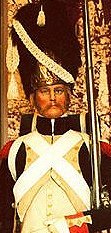 In 1814 Napoleon bid farewell to the Guard.
In 1814 Napoleon bid farewell to the Guard.
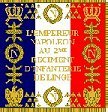

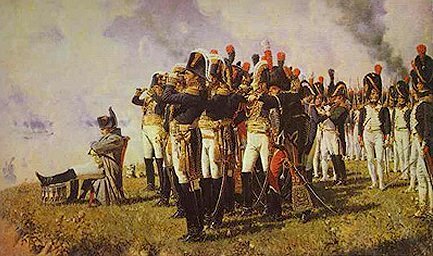 Napoleon's Guard probably represent the last true link in a chain spanning the ages.
"War's history tells of many elite guards which, in their times, formed living walls
around their rulers' thrones. The Persian 'Immortals' had a support contingent of
concubines... Israel's King David kept a bodyguard of Philistine mercenaries.
Alexander the Great rode amid the nobly-born Royal Squadron of his
Napoleon's Guard probably represent the last true link in a chain spanning the ages.
"War's history tells of many elite guards which, in their times, formed living walls
around their rulers' thrones. The Persian 'Immortals' had a support contingent of
concubines... Israel's King David kept a bodyguard of Philistine mercenaries.
Alexander the Great rode amid the nobly-born Royal Squadron of his 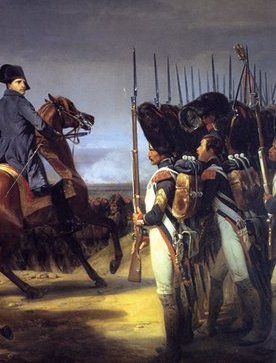 While campaigning, the guardsmen were the equal of any formation in the Imperial Army.
Seldom used in the early campaigns, they were quite active by 1813 and 1814 and became
Napoleon's shock troops during the campaigns in Germany and France.
Napoleon wanted a strong Guard for several reasons. It was the wall of bayonets
against enemies foreign and domestic about his throne, and a reserve of elite troops
under his immediate control. No Napoleonic troop marched into battle with more confidence and promise of military
glory than the Imperial Guard. They embodied the physical strength and bravery that
characterized anciet warriors.
While campaigning, the guardsmen were the equal of any formation in the Imperial Army.
Seldom used in the early campaigns, they were quite active by 1813 and 1814 and became
Napoleon's shock troops during the campaigns in Germany and France.
Napoleon wanted a strong Guard for several reasons. It was the wall of bayonets
against enemies foreign and domestic about his throne, and a reserve of elite troops
under his immediate control. No Napoleonic troop marched into battle with more confidence and promise of military
glory than the Imperial Guard. They embodied the physical strength and bravery that
characterized anciet warriors.
 Approx. 50,000 foot and horse guardsmen had been reduced to 1,100.
(Nafziger - "Lutzen and Bautzen" p 6)
Approx. 50,000 foot and horse guardsmen had been reduced to 1,100.
(Nafziger - "Lutzen and Bautzen" p 6)
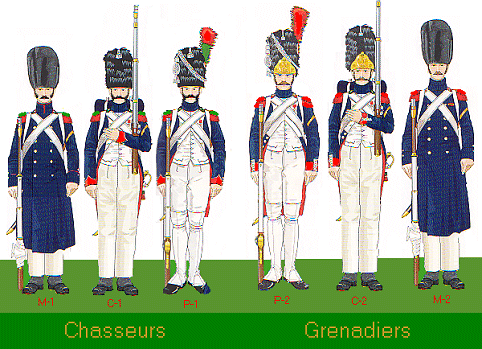
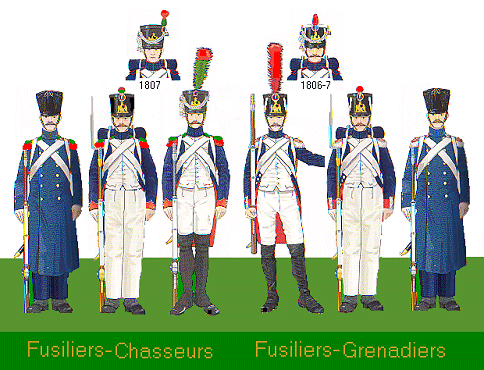
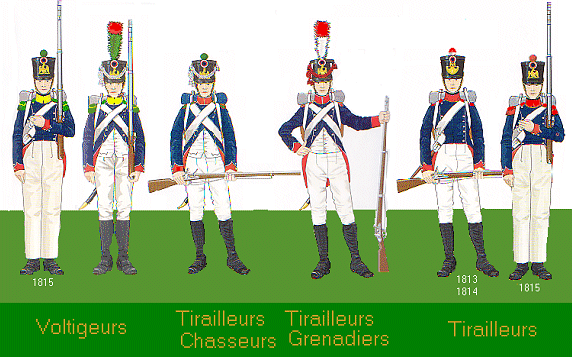
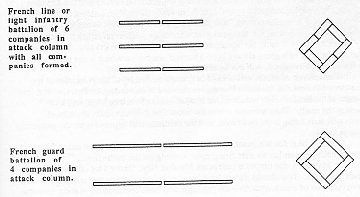 Napoleon changed the organization of battalion from 8 (smaller) companies to 4 (larger)
ones. This organization lasted until the end of Napoleonic wars.
For example in 1815 according to Article 2. (Decree of April 8th) Guard regiment "will
consist of 2 battalions, each of 4 companies."
Napoleon changed the organization of battalion from 8 (smaller) companies to 4 (larger)
ones. This organization lasted until the end of Napoleonic wars.
For example in 1815 according to Article 2. (Decree of April 8th) Guard regiment "will
consist of 2 battalions, each of 4 companies."
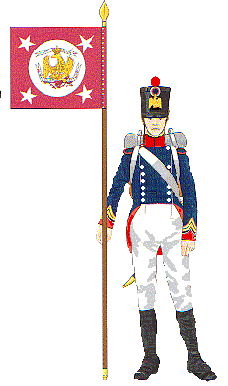 "The Young Guard infantry appeared in 1809 with the organization of two regiments each of
tiraileurs-grenadiers and tirailleurs-chasseurs. Their cadres came from the Old Guard;
their privates were the strongest and best educated men from the current class of conscripts.
There were also two regiments each of conscripts-grenadiers and conscripts-chasseurs,
likewise taken directly from the newly summoned conscripts. Their enlisted cadre was from
the (Guard) fusiliers; their lieutenants were students from St. Cyr. The cadre, especially
its senior officers, did not take kindly to being in 'conscript' outfits.
"The Young Guard infantry appeared in 1809 with the organization of two regiments each of
tiraileurs-grenadiers and tirailleurs-chasseurs. Their cadres came from the Old Guard;
their privates were the strongest and best educated men from the current class of conscripts.
There were also two regiments each of conscripts-grenadiers and conscripts-chasseurs,
likewise taken directly from the newly summoned conscripts. Their enlisted cadre was from
the (Guard) fusiliers; their lieutenants were students from St. Cyr. The cadre, especially
its senior officers, did not take kindly to being in 'conscript' outfits.
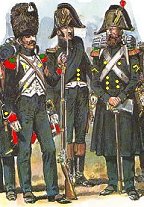
 The two regiments were formed in 1806 from veterans with at
least 6 years' service. Soon these units were disbanded and - in 1810 - the regiment of Dutch
Grenadiers took on the name 2nd Regiment of Foot Grenadiers. The Dutchmen wore white
instead of dark blue uniforms. (In 1811 they were renamed to 3rd Regiment of Foot Grenadiers
and in 1813 were disbanded.)
The two regiments were formed in 1806 from veterans with at
least 6 years' service. Soon these units were disbanded and - in 1810 - the regiment of Dutch
Grenadiers took on the name 2nd Regiment of Foot Grenadiers. The Dutchmen wore white
instead of dark blue uniforms. (In 1811 they were renamed to 3rd Regiment of Foot Grenadiers
and in 1813 were disbanded.)
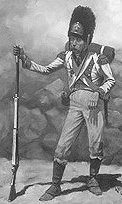
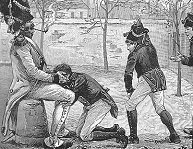 In 1810, the Regiment of Foot Grenadiers of the Dutch Royal Guard (Regiment de Grenadiers
de la Garde Royale Hollandaise) was incorporated into the French Guard as the 2nd Regiment of Foot
Grenadiers. They wore white uniforms and were much admired by the people of Versailles.
In 1810, the Regiment of Foot Grenadiers of the Dutch Royal Guard (Regiment de Grenadiers
de la Garde Royale Hollandaise) was incorporated into the French Guard as the 2nd Regiment of Foot
Grenadiers. They wore white uniforms and were much admired by the people of Versailles.
 The Fusiliers (Fusiliers de la Garde) were formed in 1806 from selected conscripts
taken from infantry and from departamental reserve companies. In 1806 the height requirement
was 168 cm (soon it was heightened to 173 cm).
Napoleon writes: "Young men who volunteer, may enlist in the two fusilier regiments if
they are strong and healthy and measure not less than 5'8" (173 cm)."
The Fusiliers (Fusiliers de la Garde) were formed in 1806 from selected conscripts
taken from infantry and from departamental reserve companies. In 1806 the height requirement
was 168 cm (soon it was heightened to 173 cm).
Napoleon writes: "Young men who volunteer, may enlist in the two fusilier regiments if
they are strong and healthy and measure not less than 5'8" (173 cm)."
 The Polish Foot Grenadiers of the Imperial Guard are known under three names:
The Polish Foot Grenadiers of the Imperial Guard are known under three names: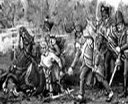 In Leipzig the Polish grenadiers captured Austrian General Merveldt, then fought in
Probstheida, and finally in Leipzig itself. The destruction of (Polish) VIII Corps and the
death of Prince Poniatowski had a decisive impact on the morale of
the brave grenadiers. Kurcjusz surrendered to the Allies near Weissenfels and many soldiers deserted.
According to Yves Martin the remnants of the battalion under Cpt. Smett fought at Hanau. Majority of the deserters joined other Polish troops.
In the end of 1813, the battalion was disbanded and its men are transferred to the cavalry, 3e Guard Eclaireurs.
(Yves Martin - "Polish Grenadiers of the Imperial Guard, 1813")
In Leipzig the Polish grenadiers captured Austrian General Merveldt, then fought in
Probstheida, and finally in Leipzig itself. The destruction of (Polish) VIII Corps and the
death of Prince Poniatowski had a decisive impact on the morale of
the brave grenadiers. Kurcjusz surrendered to the Allies near Weissenfels and many soldiers deserted.
According to Yves Martin the remnants of the battalion under Cpt. Smett fought at Hanau. Majority of the deserters joined other Polish troops.
In the end of 1813, the battalion was disbanded and its men are transferred to the cavalry, 3e Guard Eclaireurs.
(Yves Martin - "Polish Grenadiers of the Imperial Guard, 1813")
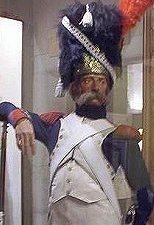 Picture: the old of the Grenadiers of Old Guard. Musee l'Armee.
Picture: the old of the Grenadiers of Old Guard. Musee l'Armee.
 Napoleon selected his guardsmen carefully and the requirements were not easy to meet for the
candidates. In 1806 only one man from each infantry battalion was admitted to the Old Guard.
The requirements were:
Napoleon selected his guardsmen carefully and the requirements were not easy to meet for the
candidates. In 1806 only one man from each infantry battalion was admitted to the Old Guard.
The requirements were: In 1809 the Foot Grenadiers and Foot Chasseurs took 456 best NCOs from the army, they
became privates in the Old Guard. The Guard was in its peak. In 1814 the 1st Chasseurs
still had many old-timers: sapper Rothier - 21 years' service, 2 wounds,
Private Stoll - 22 years' service and 20 campaigns, and so forth.
In 1809 the Foot Grenadiers and Foot Chasseurs took 456 best NCOs from the army, they
became privates in the Old Guard. The Guard was in its peak. In 1814 the 1st Chasseurs
still had many old-timers: sapper Rothier - 21 years' service, 2 wounds,
Private Stoll - 22 years' service and 20 campaigns, and so forth.
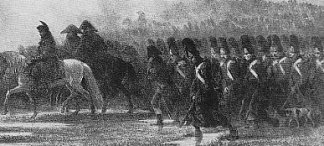 The long retreat from Russia destroyed the Old Guard.
The survivors' cheeks were hollow. They had lived on horse flesh half roasted and rye
water which in the absence of salt they seasoned with gunpowder. Their tattered uniforms
and their feet being enveloped in shreds of coarse cloth made a sad sight.
That "column of granite" had melted away ! In the end of the campaign only 408 grenadiers and 415 chasseurs were still in the ranks.
Many were frost bitten, or died of hunger and exhaustion.
The long retreat from Russia destroyed the Old Guard.
The survivors' cheeks were hollow. They had lived on horse flesh half roasted and rye
water which in the absence of salt they seasoned with gunpowder. Their tattered uniforms
and their feet being enveloped in shreds of coarse cloth made a sad sight.
That "column of granite" had melted away ! In the end of the campaign only 408 grenadiers and 415 chasseurs were still in the ranks.
Many were frost bitten, or died of hunger and exhaustion.
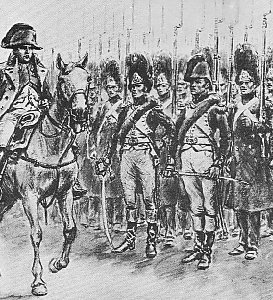 You cannot exaggerate about these lads: they were battle-hardened veterans, bold, and
physically strong. They were convinced to the point of arrogance,
that they are the most ferocious fighters on earth- and the amusing thing about it is that
they were. If they had the chance to fight today in a pub, they would take
the opponents to the cleaners, then drive them back in a school bus sobbing like the
muppets.
You cannot exaggerate about these lads: they were battle-hardened veterans, bold, and
physically strong. They were convinced to the point of arrogance,
that they are the most ferocious fighters on earth- and the amusing thing about it is that
they were. If they had the chance to fight today in a pub, they would take
the opponents to the cleaners, then drive them back in a school bus sobbing like the
muppets.
 The Grenadiers and Chasseurs did fight in numerous battles; Eylau (1807),
The Grenadiers and Chasseurs did fight in numerous battles; Eylau (1807),
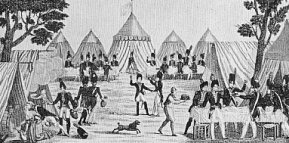 The Emperor was proud of their reputation, appearance, and always gave them a prominent
place in his great exhibitions at Paris and elsewhere. They were pampered.
In 1807 after the Peace Treaty between Russia and France was concluded,
"The engineers had built a large wooden hut in which the officers of the Guard were to feast their
erstwhile opponents. On the 30th the sun shone briliantly in a cloudless sky. In a well-chosen meadow, a cannon-shot from the town, planks nailed to trestles formed
picninc tables for the 'brotherly feast', arranged around a square in which the band would play.
The meal consisted of soup, beef, mutton, pork, goose and chicken. To drink: beer, brandy in barrels
at the ends of the tables. The Guards ate standing.
The Emperor was proud of their reputation, appearance, and always gave them a prominent
place in his great exhibitions at Paris and elsewhere. They were pampered.
In 1807 after the Peace Treaty between Russia and France was concluded,
"The engineers had built a large wooden hut in which the officers of the Guard were to feast their
erstwhile opponents. On the 30th the sun shone briliantly in a cloudless sky. In a well-chosen meadow, a cannon-shot from the town, planks nailed to trestles formed
picninc tables for the 'brotherly feast', arranged around a square in which the band would play.
The meal consisted of soup, beef, mutton, pork, goose and chicken. To drink: beer, brandy in barrels
at the ends of the tables. The Guards ate standing.
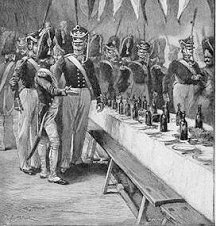 The Russians, initially suspicious and awkward, were
reassured by the French. Coignet has left a detailed account of this feast, and although he
may have exaggerated some details, he did so inadvertently, having written his memoirs more than 30 years after
leaving the service and one can understand that this was in no way a formal banquet.
The Russians, initially suspicious and awkward, were
reassured by the French. Coignet has left a detailed account of this feast, and although he
may have exaggerated some details, he did so inadvertently, having written his memoirs more than 30 years after
leaving the service and one can understand that this was in no way a formal banquet.
 Marshal Jean Lannes was one of the first commanders of the Guard.
Marshal Jean Lannes was one of the first commanders of the Guard.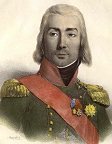 Bessières was born in southern France in 1768.
He took part in numerous campaigns and repeatedly distinguished himself for valour.
Jean-Baptiste Bessieres took over the Guard and gave it careful, efficient administration.
Bessieres was tall man with a youthful face. Despite being very rigorous in discipline,
he was adored by every guardsman for his honesty, even temper, and bravery.
His orders and speeches were cold and dry and he was the only marshal who kept
the old-fashioned military style of both powdering his hair and wearing it in a long queue.
Bessieres was excellent cavalryman and gallant fighter, thourough soldier and all soldier.
His cold courage never flinched, in crisis of battle a sudden beserk fury possessed him.
Bessières was killed by a cannon ball which ricocheted off a wall and hit him in the hand. He died from blood loss.
[Bessieres] "... was personally beloved to an extraordinary extent amongst his soldiers, and
(unlike most of the French generals of the time) amongst his opponents. It is said that masses were performed for
his soul by the priests of insurgent Spain, and the king of Saxony raised a monument to his memory." (- wikipedia)
Bessières was born in southern France in 1768.
He took part in numerous campaigns and repeatedly distinguished himself for valour.
Jean-Baptiste Bessieres took over the Guard and gave it careful, efficient administration.
Bessieres was tall man with a youthful face. Despite being very rigorous in discipline,
he was adored by every guardsman for his honesty, even temper, and bravery.
His orders and speeches were cold and dry and he was the only marshal who kept
the old-fashioned military style of both powdering his hair and wearing it in a long queue.
Bessieres was excellent cavalryman and gallant fighter, thourough soldier and all soldier.
His cold courage never flinched, in crisis of battle a sudden beserk fury possessed him.
Bessières was killed by a cannon ball which ricocheted off a wall and hit him in the hand. He died from blood loss.
[Bessieres] "... was personally beloved to an extraordinary extent amongst his soldiers, and
(unlike most of the French generals of the time) amongst his opponents. It is said that masses were performed for
his soul by the priests of insurgent Spain, and the king of Saxony raised a monument to his memory." (- wikipedia)
 Francois-Joseph Lefebvre had a German accent, a very loud voice and a sergeant's vocabulary.
But he looked after his guardsmen as if they were his own children.
Lefebvre was an outstanding 'general of execution, an excellent leader of men, but given a semi-independent mission
he was apt to go looking for a head to hit, regardless of orders. The Old Guard loved him for simplicity
and for ten other reasons. But Napoleon was not so impressed, he wrote "There is such imbecility in Lefebvre's correspondence
that I can't comprehend it."
Francois-Joseph Lefebvre had a German accent, a very loud voice and a sergeant's vocabulary.
But he looked after his guardsmen as if they were his own children.
Lefebvre was an outstanding 'general of execution, an excellent leader of men, but given a semi-independent mission
he was apt to go looking for a head to hit, regardless of orders. The Old Guard loved him for simplicity
and for ten other reasons. But Napoleon was not so impressed, he wrote "There is such imbecility in Lefebvre's correspondence
that I can't comprehend it."
 Edouard-Adolphe-Casimir-Joseph Mortier was the commander of the Young Guard.
Mortier ('mortar' in French :=) was a huge man, with 6,6" he was the tallest of all marshals.
Mortier received better-than average education at the English Collage of Douai (his mother
was English). Mortier was cheerful and unassuming, and easily influenced by his colleagues,
until the shooting started. Then he suddenly set an example of unbreakble courage.
In 1814 while many marshals (incl. Ney) bugged out, Mortier remained loyal.
Edouard-Adolphe-Casimir-Joseph Mortier was the commander of the Young Guard.
Mortier ('mortar' in French :=) was a huge man, with 6,6" he was the tallest of all marshals.
Mortier received better-than average education at the English Collage of Douai (his mother
was English). Mortier was cheerful and unassuming, and easily influenced by his colleagues,
until the shooting started. Then he suddenly set an example of unbreakble courage.
In 1814 while many marshals (incl. Ney) bugged out, Mortier remained loyal.
 Picture: Dorsenne and the Old Guard
under heavy artillery fire at Wagram.
Picture: Dorsenne and the Old Guard
under heavy artillery fire at Wagram.
 The son of a wax-maker, took part in the great victory of Fleurus (neare battlefield of Ligny) in 1794. Friant was promoted to
Général de Brigade on 13 June 1795.
In the Austerlitz campaign of 1805, Friant's division earned a reputation for rapid and effective marching.
(70 miles in 46 hours from Vienna to Austerlitz and arriving just in time to counterattack the Allies at Tellnitze and
Sokolnitze on the morning of 2 December. In the fighting Friant had three horses killed under him.
In Auerstadt (1806) Friant's division advanced on the right, turning the Prussian left flank. The infantry of Friant and Gudin,
standing in square, withstood a massive cavalry attack led by Blucher himself.
In Eylau (1807) Friant's division arrived to reinforce the French right on the morning
of 8 February, helping to turn a near-defeat into a stalemate. In Wagram (1809)
Friant was wounded by a shell fragment during the successful storming of the Square Tower at Markgrafneusiedl.
In Borodino (1812) Friant's division captured Bagration Fleches. After Dorsenne's death in 1812, Friant took over the
Old Guard. He distinguished himself in 1813 and 1814 in every battle he fought. In Waterloo (1815) Friant led the Middle Guard in the attack on the Allied center, where he was wounded yet again.
The son of a wax-maker, took part in the great victory of Fleurus (neare battlefield of Ligny) in 1794. Friant was promoted to
Général de Brigade on 13 June 1795.
In the Austerlitz campaign of 1805, Friant's division earned a reputation for rapid and effective marching.
(70 miles in 46 hours from Vienna to Austerlitz and arriving just in time to counterattack the Allies at Tellnitze and
Sokolnitze on the morning of 2 December. In the fighting Friant had three horses killed under him.
In Auerstadt (1806) Friant's division advanced on the right, turning the Prussian left flank. The infantry of Friant and Gudin,
standing in square, withstood a massive cavalry attack led by Blucher himself.
In Eylau (1807) Friant's division arrived to reinforce the French right on the morning
of 8 February, helping to turn a near-defeat into a stalemate. In Wagram (1809)
Friant was wounded by a shell fragment during the successful storming of the Square Tower at Markgrafneusiedl.
In Borodino (1812) Friant's division captured Bagration Fleches. After Dorsenne's death in 1812, Friant took over the
Old Guard. He distinguished himself in 1813 and 1814 in every battle he fought. In Waterloo (1815) Friant led the Middle Guard in the attack on the Allied center, where he was wounded yet again.
 The foot chasseurs were commanded by Jerome Soulès.
He was born on 24 August 1760, spoke with German accent and enjoyed reputation as a great
fighter. There was however a darker side of this warrior. When in 1807 after the peace
of Tilsit Soulès and his 1st Regiment of Foot Chasseurs
had returned to France the customs officers wanted to do their duty and visit the
transports of Soules and his men.
The response of Soulès was simple: "if only one of your toll-collectors dare lay a hand on the boxes of my old rabbits,
I will have them all f**** drowned in the Rhine River like kittens !" His body language was
"you don't wanna mess with me" thing. In 1815 Soules cast his vote for the death
of Marshal Ney, which was not very noble of him.
The foot chasseurs were commanded by Jerome Soulès.
He was born on 24 August 1760, spoke with German accent and enjoyed reputation as a great
fighter. There was however a darker side of this warrior. When in 1807 after the peace
of Tilsit Soulès and his 1st Regiment of Foot Chasseurs
had returned to France the customs officers wanted to do their duty and visit the
transports of Soules and his men.
The response of Soulès was simple: "if only one of your toll-collectors dare lay a hand on the boxes of my old rabbits,
I will have them all f**** drowned in the Rhine River like kittens !" His body language was
"you don't wanna mess with me" thing. In 1815 Soules cast his vote for the death
of Marshal Ney, which was not very noble of him.
 One of the most popular divisional commanders of the Young Guard was Henri-Francois Delaborde
(1764-1833). Delaborde was son of a baker and was educated for the church. He was a leanly
big man and spoke Latin language. According to Elting "he said little, but what he said was
very definite." In the beginning of the French Revolution he joined the volunteers and passing rapidly through
all the junior grades was made general of brigade after the battle of Rhein-Zabern (1793).
He was present at the siege of Toulon and promoted general of division. In 1807 Delaborde
was training new conscripts at his camp at Pontivy in France. In 1808 he fought a brillant
delaying action at Rolica against British troops that outnumbered him 4 to 1. Amazingly the
French lost only 550 men and retreated in fighting order. The British lost approx. 500 men.
In 1812 Delaborde commanded the 1st Infantry Division of Young Guard. He traveled by carriage. Only 48, his bent back
and protruding paunch made him look much older. Delaborde distinguished himself at Krasne
against the Russians. He led his division of Young Guard with these words:
"My children, when you smell powder for the first time, it is stylish to stick up your nose !"
The Bourbons hated him and wanted to execute for supporting Napoleon to the very end.
One of the most popular divisional commanders of the Young Guard was Henri-Francois Delaborde
(1764-1833). Delaborde was son of a baker and was educated for the church. He was a leanly
big man and spoke Latin language. According to Elting "he said little, but what he said was
very definite." In the beginning of the French Revolution he joined the volunteers and passing rapidly through
all the junior grades was made general of brigade after the battle of Rhein-Zabern (1793).
He was present at the siege of Toulon and promoted general of division. In 1807 Delaborde
was training new conscripts at his camp at Pontivy in France. In 1808 he fought a brillant
delaying action at Rolica against British troops that outnumbered him 4 to 1. Amazingly the
French lost only 550 men and retreated in fighting order. The British lost approx. 500 men.
In 1812 Delaborde commanded the 1st Infantry Division of Young Guard. He traveled by carriage. Only 48, his bent back
and protruding paunch made him look much older. Delaborde distinguished himself at Krasne
against the Russians. He led his division of Young Guard with these words:
"My children, when you smell powder for the first time, it is stylish to stick up your nose !"
The Bourbons hated him and wanted to execute for supporting Napoleon to the very end.
 Paul-Jean-Baptiste Poret de Morvan was born in April 1777. In 1811 he became colonel of the 34th Regiment of Line
Infantry, in 1813 colonel-major of 3rd Regiment of Tirailleurs of the Young Guard, and
in 1815 colonel of 3rd Regiment of Foot Grenadiers of the Middle Guard.
He was a man of a robust stature, and every drop of blood in his frame came from
the fiercest of fighting stock. At Waterloo fought with great determination against
the numerically superior British-German-Netherland troops. Commander of the Legion d’Honneur : 26 May 1813
Baron of the Empire: 14 August 1813. De Morvan died in 1834.
Paul-Jean-Baptiste Poret de Morvan was born in April 1777. In 1811 he became colonel of the 34th Regiment of Line
Infantry, in 1813 colonel-major of 3rd Regiment of Tirailleurs of the Young Guard, and
in 1815 colonel of 3rd Regiment of Foot Grenadiers of the Middle Guard.
He was a man of a robust stature, and every drop of blood in his frame came from
the fiercest of fighting stock. At Waterloo fought with great determination against
the numerically superior British-German-Netherland troops. Commander of the Legion d’Honneur : 26 May 1813
Baron of the Empire: 14 August 1813. De Morvan died in 1834.

